Time Keeping in the timeless world of BREAK!!
I just love BREAK!!.
If you haven’t been navigating the OSR spheres (OSpheRes?) at all in the last ten years, there is a small chance you haven’t heard of BREAK!!. This tabletop roleplaying game is a love letter to classic JRPG and anime that builds on old-school D&D to deliver a fresh take on the tired old elfgame. What makes it work so well for me is that it is serious, but also not.
Granted, seriously-but-also-not is the way I run every dee-endee, but the whimsical and anachronistic vibe in Outer World (the game’s setting) gels super well with the heroic-yet-deadly mechanics. Much better than anything I’ve ever seen.
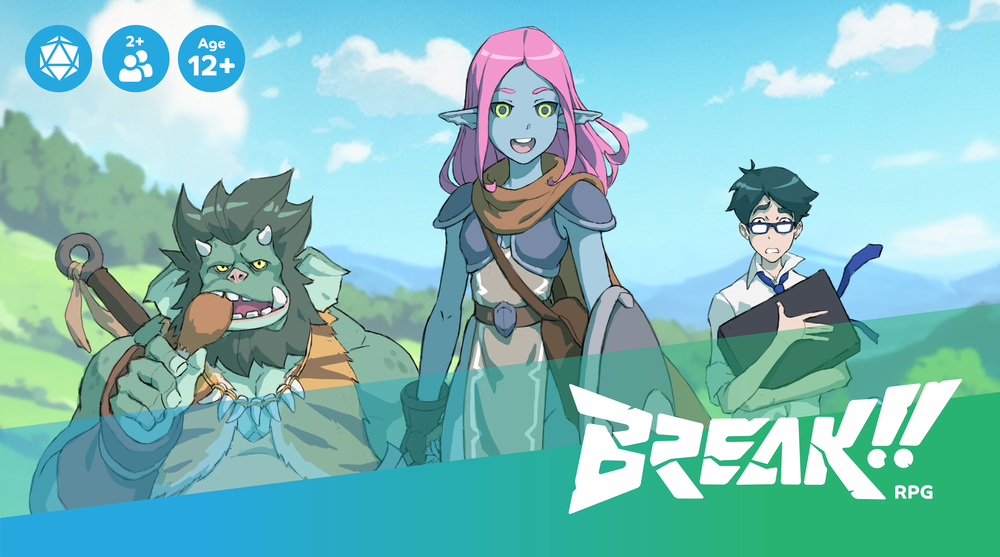 Grey Wizard’s art is just 👩🍳👌😘
Grey Wizard’s art is just 👩🍳👌😘
But anyway. One of the specificities of Outer World is that its sun (or to be exact, the Sun Machine) doesn’t revolve around the planet. The machine was broken long ago, and for eons it has been hovering above one of the continents. This gives distinct atmospheres and themes to regions depending where they are relative to the unmoving star, which is a genius idea. And as a GM, it also makes me think about how communities keep track of time. The book (or Reynaldo on the BREAK!! Discord — my brain doesn’t remember things anymore) says that people are more chilled in Outer World because they aren’t slaves to clocks or bells like they are in Other World (that’s our world, or a version of it). Which is another great worldbuilding detail.
Playing an NPC in my first session though, I found myself stumped when a length of time needed to be stated. “The search party is leaving tomor… er, in the morn… er, at first ligh… at Third Bell!” is more or less what I ended up saying. I could have said “When we’re all awake”, but that’s not what came out. I just made a mental note to answer the time-keeping question when I prep a settlement.
Hence the following table.
The time-keeping method here (d20)
- None. People don’t care about anyone’s need for sleep. People around here a always a bit on edge.
- None, but people have a system of signals (signs on doors, flags, hats on pegs…) to indicate when they’re resting.
- Marked candles are used by families and work groups to tell when the next activity or sleep cycle (“lights”) happens. Not in a coordinated way though.
- People have a natural sense of time. Their sleep and activity cycles are very short. (Like a one-hour nap every two hours.)
- Everyone gets to be in charge of keeping time for a week. They ring a gong at intervals that feel right to them. People associate according to their views on timekeeping and work cycles.
- The locals model their sleep cycles on the prides or roarclaws who live around here. They snack and nap a lot.
- A colony of honeycrawls living among the villagers provides them with a strict schedule.
- The flowers of the starchid tree open and close at regular intervals. Different species have different schedules, and people and communities choose the flowers that suit their personalities.
- A goblin inventor maintains a network of cogs and cables connecting lumi-slime jars. Tiny hammers and pop guns awake some slimes every handful of hours. The number of illuminated jars marks the time of the day.
- Bells are rung six times a day by local monks. The intervals follow meditation cycles and are simply called “bells”.
- The nearby volcano spouts harmless fireworks three times a day. People call these periods flames (morning), flares (afternoon), and fumes (night).
- A gigantic clocktower powered by an ancient arcane source. It has 21 hours. The last one is the Witching Hour, when ambiant mana surges.
- An old clepsydre is painstakingly kept in working order inside a temple-workshop. The shaolingineers who live there raise a different flag every two hours (13 flags total).
- People use glowing mana-rocks to tell time. These stones have a colour cycle, with colder hues being used as resting time. Only thing is, the proximity of mana disrupts the cycle. And adventurers bring a lot of mana with them.
- An antique warbot has been dying under the town for as long as anyone can remember. A loud buzzing alarm resonates four times a day. These four cycles are called “throes”.
- The synthaur (a bio-mechanoid with the lower body of a largzard) who serves as the militia captain has an internal clock. They loudly announce every hour. Even at night.
- Luminous dronekites are seen dancing high in the sky for about half the day. People are superstitiously afraid of them, so they stay indoors to rest and sleep when they are visible.
- An oldtech clock network is maintained by a clan of rai-nekos. The digital clocks are connected to each other by radio waves. They may even have a radio station with a morning DJ.
- The settlement owns one or more SMT clocks, plugged into the outer-world-wide Standard Merchant Time arcane network. (Thanks Burn!)
- There are two concurrent and possibly competing time keeping systems. Roll again twice.
 This is how I envision the clocks of entry 18
This is how I envision the clocks of entry 18
Note: with no objective way to measure days, some activity cycles will be much shorter than others. One community’s day may last an objective 16 hours when the next one’s is closer to 28 hours. Does it matter? Only if you have a human stray who brought a Swiss wristwatch with them, I guess.
An Unfinished FKR Game to Play Your 5E Character
*Edit 27/12/23: removed the Arbitrary Calculation mechanic; Changed the referee/narrator to Diceless Motherfucker; Clarified checking and crossing out lines; Fixed the dragon librarian.
I cobbled this together last week, following an urge to rework something I’d written during the lockdowns and never used. It’s up here so I don’t forget about it again and might evolve if I get to run it. It uses the key principle in OZR, the Obliviax Oracle table, and borrows some lingo from CRACK!. The break rule comes from one of John Grümph’s many, many games (I’m just not sure which…).
Epic Five
Reckless Attack, Dread Ambusher, Fey Ancestry… One of the things that we like about making character in the Fifth Edition of The Wannabe Billion Dollar Brand is the cool abilities we get from backgrounds, classes, races, spells, magic items, and the like.
Of course, each of these cool sounding abilities come with their own rules, for the sake of gameplay and balance. Which is good, of course, ’cause we play the game to play the game, but still… What if we were just using the cools words?
“You’re a Spell sniper? Well, you can shoot that undead sentry in the skull with a silent magic missile. Roll a d20.”
As you’d expect, you need one DM (Diceless Motherfucker) and from one to four players to play.
Bring your character
You need a sheet of paper with your character’s name and 20 numbered lines, preferably with checkboxes.
Next, fill in a number of lines equal to your character’s level with the cool words from your D&D character sheet. (It should be a minimum of 5 lines, even for a low level character.)
Some examples of what you can write on a line :
- 1. Dwarf of the Hollow Hills <= elaborate on your race to make it less bland
- 2. Seasoned Battle Master <= describe your class however you like
- 3. Gladiator champion five years in a row <= same with your background
- 4. Strong as an ox <= because you have 19 STR
- 5. Expert acrobat <= you have to mention that +15 skill, don’t you?
- 6. Dim as a wet candle <= you have 6 INT and you’d like it to feature in the game. That’s fair!
- 7. Student of War <= class features are great entries, no need to remember what they do
- 8. Riposte <= and so are sub-features such as maneuvers and spells
- 9. Fireball <= wait, you’re also a wizard? No need to write down any details here either
- 10. Extra attack <= if you really insist, but I’d rather use class features with evocative names
- 11. Berserker axe* <= important items, magical or otherwise should feature too*
- 12. lock of mam’s beard <= trinkets are important!
- 13. Double layered, custom fit chainmail hauberk <= as is armour
- 14. Magical breastplate <= and having more than one line of it will make you tankier
And that’s all! You can put your D&D character sheet away now. We wouldn’t want to make the session boring by looking up details or doing maths!
Action! Checking lines
When your character attempts something risky or is in danger, roll a d20 and aim high.
The DM uses the table below as inspiration to describe the consequences of your roll. Feel free to suggest ideas. It’s your hero after all!
Optionally, a player always describes their action and the DM builds on it.

Boosting a roll: you can check any number of lines on your character sheet to roll that many extra d20s, as long as you can justify their use in the attempt. You get to choose the result you like best. (But it you take too long, the DM is entitled to choose for you.) Optionally, the number of dice results equal or above the chosen result give you the quality of the success. The DM ultimately gets to decide which lines can and cannot be used in a given situation. But they won’t be a dick about it, and they certainly won’t refer to any corporate rulebooks or overpriced apps. So be creative!
Uncheck your lines when taking a breather: three minutes and a swig of ale if enough. But if the DM
Fight! Losing lines
Dealing hits: Your attacks, spells, and other offensive actions deal one hit per d20 rolled.
Taking hits : This covers the usual worg bites and fire bolt burns, but also conditions used by Hasbro‘s Ampersand Brand (fear, paralysis, etc.) or not (disarmed, in love, amputated…). When you get hit, you cross out (not check) one or more of your character lines. The DMay tell you which lines to cross out as directed by what just happened (being disarmed, you would lose your axe for instance). Otherwise, it is randomly determined: for each hit, roll a d20 and cross the corresponding line on your sheet. If this line is empty or already checked, you choose. It’s better if you can explain how the hits you take make you lose some of your abilities or equipment, but don’t sweat it.
Being taken out: Whenever you run out of lines to check or cross out, you are out of the game for an amount of time decided by the DM, or unless someone comes to revive you.
Non-lethal damage: As we said above, conditions can deprive you of your lines. So is social and psychological damage resulting from non combat situations. The bard losing the rap battle to the Killa Kobold Krew? The shame cost them their cutting words line.
Furthermore, some conditions limit what your character can do. Someone who’s restrained or swallowed by a hydra cannot do everything they like. In these situations, the DM will be a lot more strict with the lines you can check to boost your rolls.
Monsters and characters
The DM should have lists for monsters and NPCs representing their abilities and how resilient they are in a conflict. This works just like for your character, with a number of lines you can base on their hit dice or level in D&D or just estimate. The lines can be used to describe the NPC’s needs, character, and flaws, as well as their abilities and tactics. See examples below. Optionally, some lines can be duplicated, especially if the DM is coming up with enemies on the fly.
Also, each potential adversary has a Critter Rank (CR), which is essentially the number of lines you cross out if they hit you.
The DM doesn’t roll dice in combat. So avoiding hits or spells is on you: make a roll (boost it if you like) and beat an AC that can be indicated on the enemy’s sheet or made on the spot. Per die result meeting or beating this AC, remove one from the damage you would have taken.
Taking breaks to recover lines
Whenever you feel like they are running out of abilities, you can agree to take a break. The time it takes in the shared narrative doesn’t matter: it may be a week at a comfortable country inn, recovering from a dungeon crawl with hot bone broth and cool rye ale; or it can be a mere instant regrouping behind cover, hoping the dragon won’t be breathing its fire yet again. When you take a break, recover (uncheck and uncross out) your lines. Every player, including the DM, must agree to do so, or the break doesn’t happen.
Everyone gets a break! What is stopping you from taking as many breaks as you want? Well, a break for the heroes is also a break for the villains. While the characters are recovering, the DM gets to take a turn, essentially doing what they would do between sessions: restock the dungeon with reinforcements, make a faction move, bring a villain’s plan to fruition… anything that makes sense within the situation. The Queen’s army was been defeated by the undead horde while the party was resting behind the lines; as the heroes were catching their breath behind a rock, the dragon’s cultist allies showed up to encircle them.
Example enemies
Pixie bandit: CR 0
- Infuriating little annoyance
Human city guard: CR 1
- Bored bully
- Clunky armour
Ogre vagrant: CR 2
- Huge mofo
- $18 ^{00}$
- Hungry all the time
- Always attacks the most annoying target
Dragon librarian:* CR 4
- Huge lizard
- Claws like exacto knives
- Hovers to stay out of melee
- Deadly fire breath
- Brain-eating spells
- Needs glasses
- Easily angered by loud people
- Sad about that time they burnt down the library
Dungeon 23, May: The Cold Sea
Last month I decided to do an island crawl for a slowpocalyptic setting I’ve been thinking about. I’m not sure how interesting it is, but at least I’ve learned that I’m unable to maintain a consistent mapping style ;p
 it started relatively simple
it started relatively simple
 I did both weeks in the same couple of days
I did both weeks in the same couple of days
 but after that I added shadows
but after that I added shadows
 and then contour lines were gone
and then contour lines were gone
 no map here, I needed the space for June
no map here, I needed the space for June
All in all, I’m rather happy with the final style. I’m not good at isometric style, but I could probably make some half decent maps with a lot of practice.
More thoughts about the FKR X-Men game
I haven’t stopped thinking about his game (I even watched The Gifted) and there are a few questions that need answering. Mostly, how would I run combat and other action scenes? We obviously want these to be fast-paced and dynamic. My solutions are simple:
1. No referee rolls. Only the players roll for actions. If there really is a situation that’s NPCs only and where chance is involved, I’d just ask a question in an oracle sort of way and roll a d4:
Is Pr. Xavier able to locate Emma Frost with Cerebro when she doesn’t want to be found?
- No, and… it hurts his big brain and he’ll have to recover from the backlash
- No, but… he finds another mutant who she mind controlled recently
- Yes, but… she’s aware he found her, and very pissed off about it
- Yes, and… he has a good idea of what she’s been doing
2. Lots of lists. Lists of adversary traits (with some inspiration from Dungeon World’s monster moves); and lists of scenes or locations features (the way I used to prep for Feng Shui back in the day) so I am fictionally prepared for action.
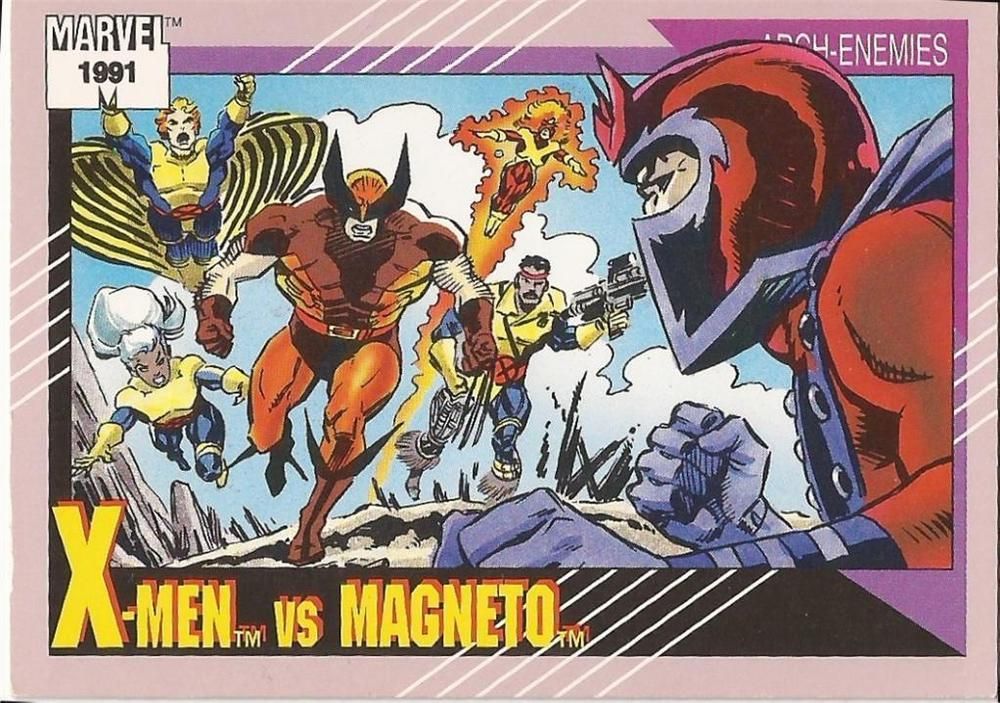 from 1991 Marvel Universe Series 2
from 1991 Marvel Universe Series 2
Non-Player Characters
Statting up NPCs without using numbers (one of my hard rules for FKR design) can easily be done like in OZR: when damaged, the enemy loses a trait (or move, or piece of equipment), which they can’t use for the rest of the scene.
The more important or powerful the character, the more traits they have. A successful attack removes the most plausible trait. Encouraging players to target their attacks or change their tactics to neutralise certain powers would be easy and very much in genre - and that’s certainly how I would play my bad guys (“How do you shoot that optic blast now that Magneto has wrapped your head in a car door, Cyclops?”)
An opponent running out or traits is defeated - their actual health status at this stage depends on what happened in the fight; they might just surrender or run away.
Enemy traits also help establish the parameters of a roll: what happens on a failure, success, or overkill. (In the previous post, I forgot to make it plain that the game doesn’t offer a difficulty scale - I’ll post some clarifications next time.)
Some NPCs of various danger levels:
- Human Rights rioter. Thick racist skull.
- Weapon X base guard. Vigilant. Assault rifle. Uses squad-based tactics to surround, flank, incapacitate.
- Toad. Superhumanly agile. Sneaks into pretty much anywhere. Spits sticky stuff. Catches something with his tongue. Gets rescued by Brotherhood members.
- Magneto. Master of Magnetism. Iron will. Telepathy-blocking helmet. Flies using Earth’s magnetic field. Deadly or incapacitating metal attacks. Blocks any attack. Mold smetal into any shape. Levitates whole buildings to make a statement. World leader (Genosha). Makes grandiloquent, inspiring speeches.
Two notes about this:
- Powerful baddies would get traits that kind of overlap, and some that don’t do much (such as Magneto’s Iron will). They’re there to soak up more punishment.
- Weaknesses should be included in NPC writeups (and influence the results and conditions of a roll), but I don’t know if they should be traits - maybe the weakness is the last trait to go?
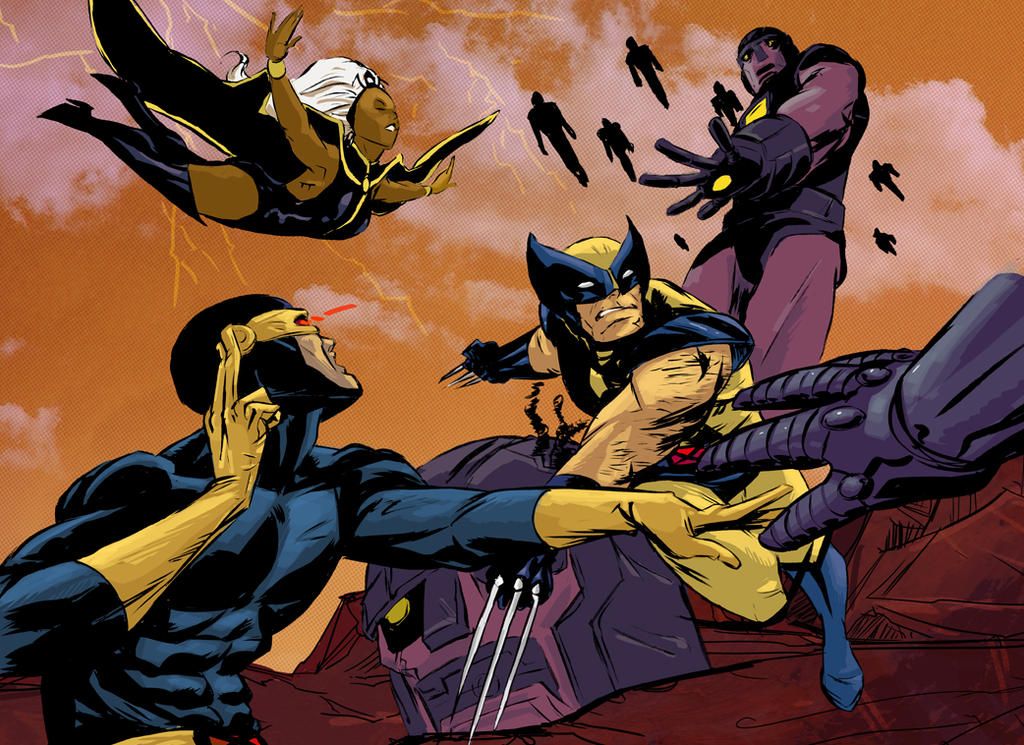 Art by Greenestreet on Deviantart
Art by Greenestreet on Deviantart
Location Stunt Lists
This simply answers the question: What cool things could happen? For fight locations, it’s a list of features to be used for PC stunts. For example, the vehicles garage on a military base would have:
- Catwalks and stairs to sneak, run and teleport on
- Garage doors that can only be open from a bullet-proof guard station overhead
- CCTV feeds; visible by garage guards; can be accessed by central command post if alarm is raised
- Lots of tools to telekinetically hurl at enemies
- A couple of humvees, a few motorbikes, and a helicopter to hijack or blow up
- Barrels of petrol and piles of tires to set on fire
- Grease pits with elevated vehicles and engine blocks swinging on chains
If I had a clear idea of what is happening in a location (a fight for example), I would also have a list of events as described below.
Action Scenes Lists
Whether a scene happens in a preordained location or not, having a handful of events, twists, and other ways to raise or change the stakes is always good. Continuing on the example above, if the plan was to have the X-Men escape from the base, I’d go with something along the lines of:
- Shift change: 4 guards show up and cross the garage. 2 relieve the ones at the entrance, and 2 climb the stairs to the guard station.
- Routine security call: guards test infrared cameras and goggles, motion detectors, etc.
- Two off-duty soldiers are having sex or doing drugs in the back of a humvee.
- If the alarm is sounded, groups of soldiers show up every few minutes. First regular guards, then heavily armoured, anti-mutant troops.
- If the X-Men don’t escape swiftly or discreetly, they can expect the turrets outside pointing at the garage doors when they go through them.
Another Stolen Idea: Sub-Locations
Over a decade ago, French publisher John Doe released Les Mille Marches a pulp adventure game by Grümph that made an impression on me. I’ll dig it out of my shelves and read those rules again, but the idea I want to borrow is simple: you don’t need a battlemap to use the environment in a fight scene. Just draw large squares in your notes, and write down some environmental conditions for each one, with advantages and . You don’t need to do this for every potential fight location, but it’ll add some flavour and tactical options to your set piece.
Characters can go from a sub-location to another willingly or not. Which sub-loc is contiguous to which depends on the fiction and/or of a map. Picture Wolverine tackling Sabretooth through a window, moving their clawo-a-clawo duel to a side alley where one or the other could take advantage of the conditions there.
Our military garage from above could have:
- Catwalks: dark and sneak friendly, easy to fall down, easy to break to make opponent fall down
- Security office: brightly lit, close quarters, people with guns
- Grease pit: slippery, danger of being crushed, power tools
- Through the garage door: not much cover, potential fire range, automated turrets
How I’d run and X-Men Game (#FKR inside)
I’ve been watching a lot of the X-Men stuff Disney+ have added to their catalogue and, as you’d expect, my brain has been wondering about Marvel mutants RPGs. I would enjoy running a short campaign centred around the Xavier School for Gifted Youngsters. Somewhere between teen drama and superheroic misson of the week.
I know there are a ton of Marvel games and I’m sure Masks would work with little adaptation but, if my brain can go berserk when it comes to making games, it often gets lazy when I want it to read rules. I know, my brain’s an unmanageable arsehole. I had to write this so I could go back to watching TV?
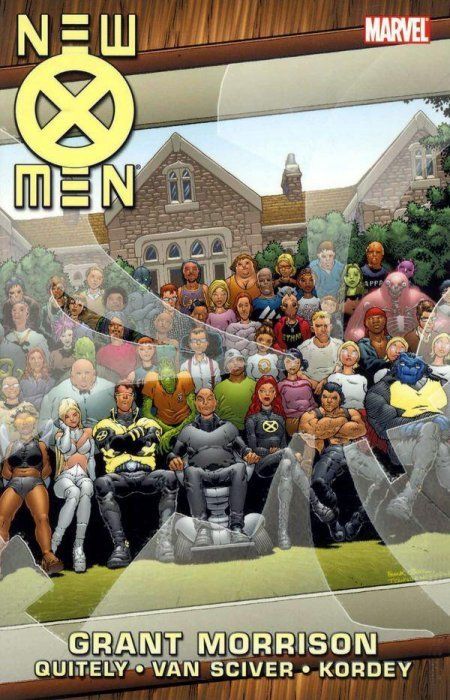 New X-Men cover by Frank Quitely
New X-Men cover by Frank Quitely
FKR, bien sûr !
When going for a game set in an existing, well-documented world, Free Kriegspiel Revolution is an obvious way to go — well at least for me. We can dive as deep as we like into Marvel comics minutiae, we can kitbash an MCU-style mashup of old and new to suit our needs. In any case, all the information we need is a click away and none of it has to be mapped to a rigid set of rules. I’d also be more free to give the game a cinematic feel if I don’t have to worry about numbers and dice pools and colour coded resolution tables.
Character Creation: a Q&A
Characters and their arcs are important in superhero stories. To keep things simple, I would just ask the players some questions; their answers would make up the character sheets. I like to keep my FKR numberless.
For legibility, I’d require that answers have a bold title or heading (and call this a trait). Traits are a comfortable way to build a character for me. Here’s an example using a well-known X-Man (or what I remember about him anyway):
What is your mutant gift?
Colossus of Steel. I can turn my body into organic metal.
Describe up to three consequences or applications of your gift.
Super Strength. My already considerable physical abilities are decupled when in steel form. Hard as Steel. Steel me can withstand a lot of physical damage.
Describe one or more weaknesses.
Heavyweight. My steel body weighs about two tons. Organic Organs. Everything that isn’t skin, muscles, or bones remains vulnerable. I need to breathe, my eyes are unprotected if open, etc.
This sums up the superpowers part of the character. Other questions would include:
- What are your powers’ limitations?
- Name three things you’re very good at.
- Name something you’re embarrassingly bad at.
- Do you have a codename, and who came up with it?
- Describe your appearance
- Where do you come from?
- What is your relationship to your family?
- How well do you accept your nature as a mutant?
- How do others describe your personality?
- How long have you been a student/teacher here?
- Who are you closest to at the school?
- Who do you dislike at the school?
- How do you see yourself after you graduate?
The frame of the campaign would of course define the list of questions. Some would be answered collectively during the first session. Some could be optional. Also I figure additional questions would arise as we play. ‘Character Q&As’ would grow as the campaign progresses, reflecting the character’s evolution in personality and ability.
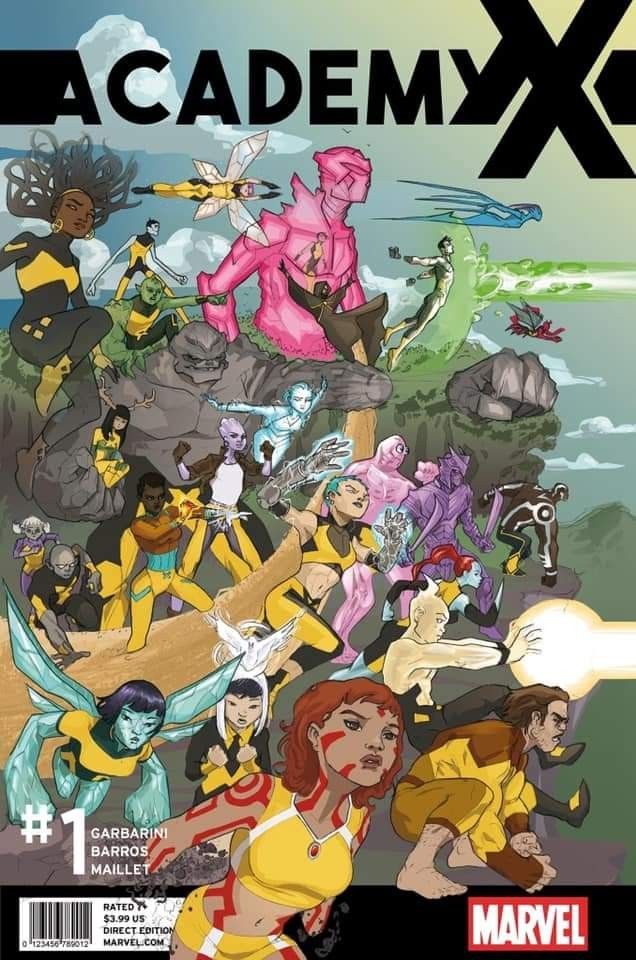 I don’t think this is a real cover but it shows a possible cast of characters
I don’t think this is a real cover but it shows a possible cast of characters
The Rules
This being FKR, I would keep these as simple as possible. We’ll roll one or more four-sided dice and we’ll amend the results with a finite superhero currency.
X-Men, Assemble your Dicepool
(Yes, I can make two weak Marvel references in one header. Call me Maria Hill-arious.) Roll when the outcome of a situation or action is unclear.
- Start with one d4, and add one for each trait that would help your character.
- External circumstances can also add dice as indicated by the referee.
- You can use your mutant potential to improve your odds: spend one X per additional die. (See below about Xs).
Look for the best result to determine the outcome:
- Catastrophe. A negative possible outcome, possibly with an extra consequence.
- Bad. Things aren’t going your way, or they do but with a cost or consequence.
- Good. You’re getting exactly what you want and nothing more.
- Overkill. The outcome is positive, but something gets out of hand.
If the highest number shows up on more than one die, the outcome, good or bad, is amplified exponentially (as a rule of thumb, double the expect effect for each additional die).
Manage your Xs
You have points called Xs to spend over the course of the session. Their number depends on both your character’s mutant potential and their current mastery of their gifts. As a teenager just discovering their power, they had one or two Xs. Magneto or Professor Xavier at the height of their power have maybe 12 or 15 points. The Dark Phoenix has… let’s not go there. I’m not writing a catalogue of NPCs.
You spend your Xs to affect the fiction when the dice or the referee aren’t being cooperative. Spend one X to:
- Roll an extra die
- Add 1 to a single die
- Avoid harm (see below)
- Sense danger just in time to react to it
- Otherwise rewrite the script: add in an item or person, describe a flashback to gain an edge, use your powers in a new way, etc.
X Cost. At the referee’s discretion, more than one point may be needed to obtain an effect.
Teamwork. If they’re helping you, your friends can spend Xs for you as long as you’re spending at least one X as well.
Regaining Xs. Your Xs refresh at the beginning of the session. You can also regain some at crucial points in the game, .as decided by the referee . They can represent preparation, morale, rest, hope, or the middle point between rage and serenity, etc. Xs are the game’s spice. And the spice must flow.
X-Men Evolution. Yes, you can permanently increase your maximum X total by training, overcoming your hindrances, and generally becoming better. I would probably sit down and think about how I want characters to increase in power in a way that is linked to their Q&A.
Harm and Death
Wounds and injuries, powers affecting you, mental stress, etc. are considered harm. Harm does not affect your dice rolls; it changes the scope of what you can do with a good roll and the consequences of a bad one. Depending on the circumstances, and as stated by the referee, permanent injuries, mental breakdown, and death can follow a bad roll.
As described above, you can spend one or more Xs to avoid harm. Until you’re out of Xs. That is when your character is risking to meet a bad ending to their story.
Game Tone. You should decide in advance of the levels of grittiness and injury detail of your game. Use media properties to establish clear guidelines, from 1970s Spider-Man cartoon’s banter-filled fights to the torture interrogations of Netflix’s Daredevil.
Some Notes
Why d4s? Well, there is a kind of symmetry between the four sides of the die and the four branches of the letter X. Also, d4s are unwieldy, unloved, yet useful in many games. They’re the mutants of our dice bags. Finally, and I haven’t ran the stats for this, but it looks like from three dice on, the numbers of overkill results becomes significant. This would push players to risk going into superhero teenager “oops!”” territory if they want to get results.
Why the overkill result? I’m diverging from the classic ‘the higher the better’ results table because powers going too far is a fun thing to have when following the exploits of young and rebellious mutants who have very good reasons to stay under the radar. If someone were to play a teacher, or even a senior student, I would let them spend their Xs to subtract from dice results. Maybe a limited number of times per session, unless they are a full-blown X-Man.
Is this hypothetic game still an FKR game? Yes. But maybe no? The point where a game has too many player-facing rules to be called Free Kriegspiel is a moving target.
Edit 27/5
Just thought about this. Will have to run some tests but I think it could be fun:
Push Your Luck rule
Don’t like the results of your roll? Reroll for your action using a single die.
- If the result is the same as your previous highest result, it compounds with it, pushing further in the direction you wanted to avoid.
- Otherwise, this as a normal 1d4 roll with its high chance of failure and overkill.
Dungeon23 April: Cave of the Unknown
Here are all the pages for my April dungeon. You’ll notice that my effort at crosshatching only lasted a week ;) Overall, I’m happy with the way this went. Especially since my March dungeon never happened and despite the fact we brough COVID back from Belgium at the beginning of the month.
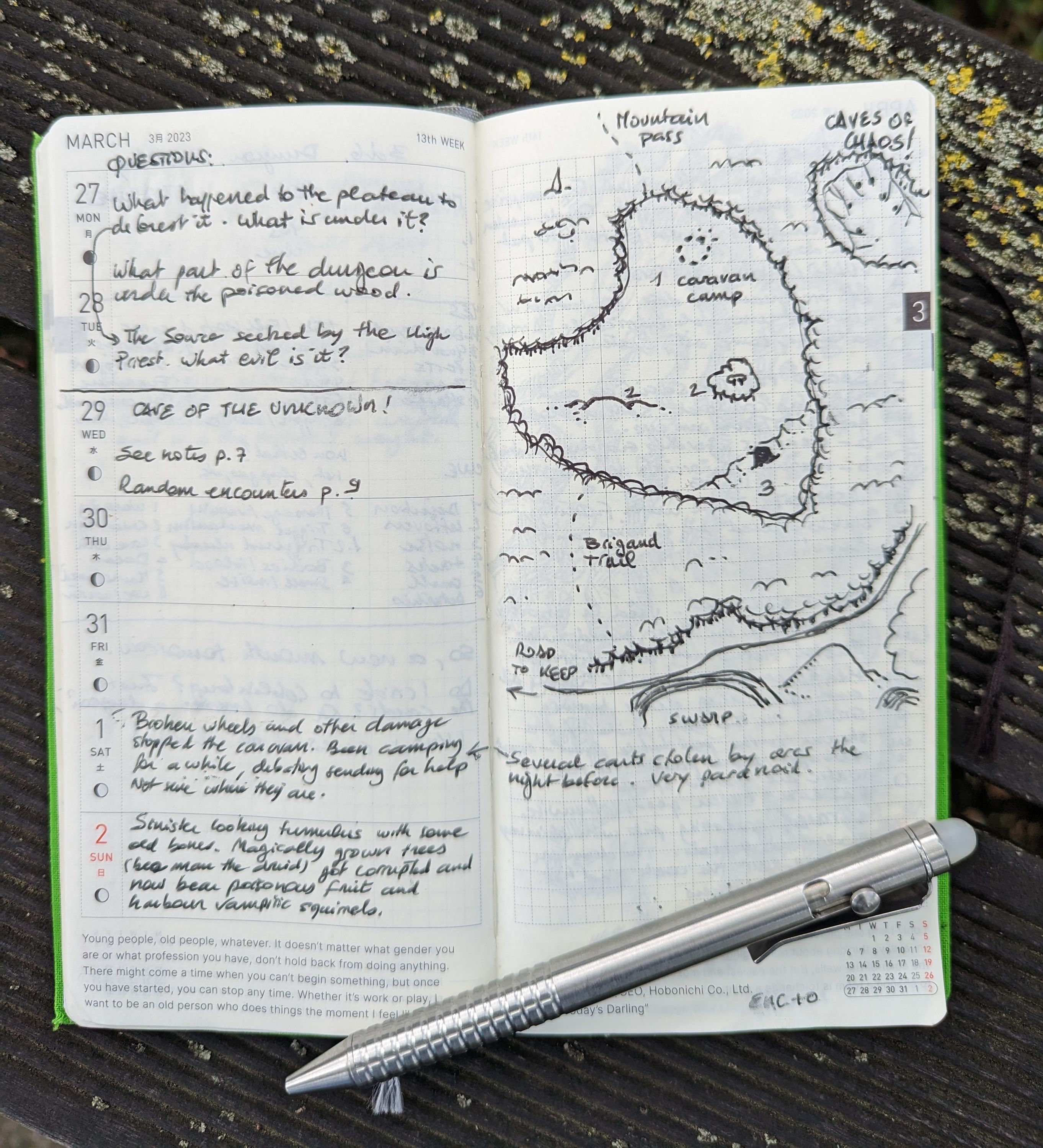 You may regognise this map
You may regognise this map
I decided to make my own version of the Cave of the Unknown, a dungeon notoriously absent from Gygax’s module B2, Keep on the Borderlands. One of the times I ran that (in the Astral Borderlands campaign that I started with Whitehack and turned into Macchiato Monsters over a couple of years) I had pegged the Cave of the Unknown as ‘The Source’ to some evil power that the clerics at the Temple of Evil Chaos were looking to exhume. The game never went there, so I had no idea of what The Source was. Well, now it is one the portals linking all my #dungeon23 dungeons.
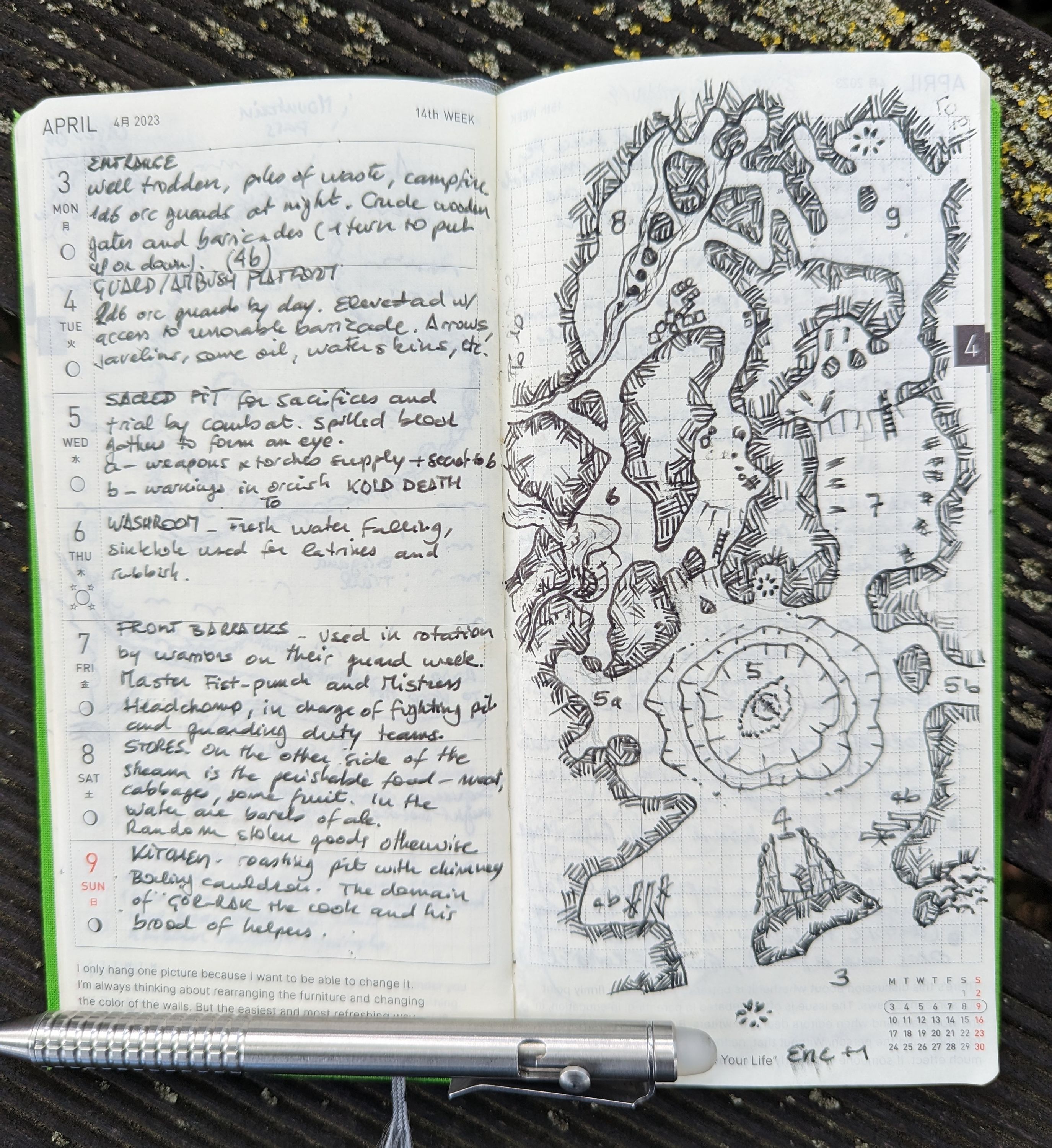 Entrance, orc defenses
Entrance, orc defenses
I used the B/X monsters tables to randomly decide on the Cave’s factions. I rolled an adventuring party, orcs, and fire salamanders. So the dungeon is inhabitated by a migrating orc tribe (migration was a big theme in this version of the Caves of Chaos) who fell under the spell of a group of experienced, evil adventurers. Using the OSE generator, I rolled a thief, an assassin, an illusionist, a gnome, and a bard, all between 5th and 9th level — it was easy to think of them as a manipulators looking to build an army to take over some settlement where they could retire.
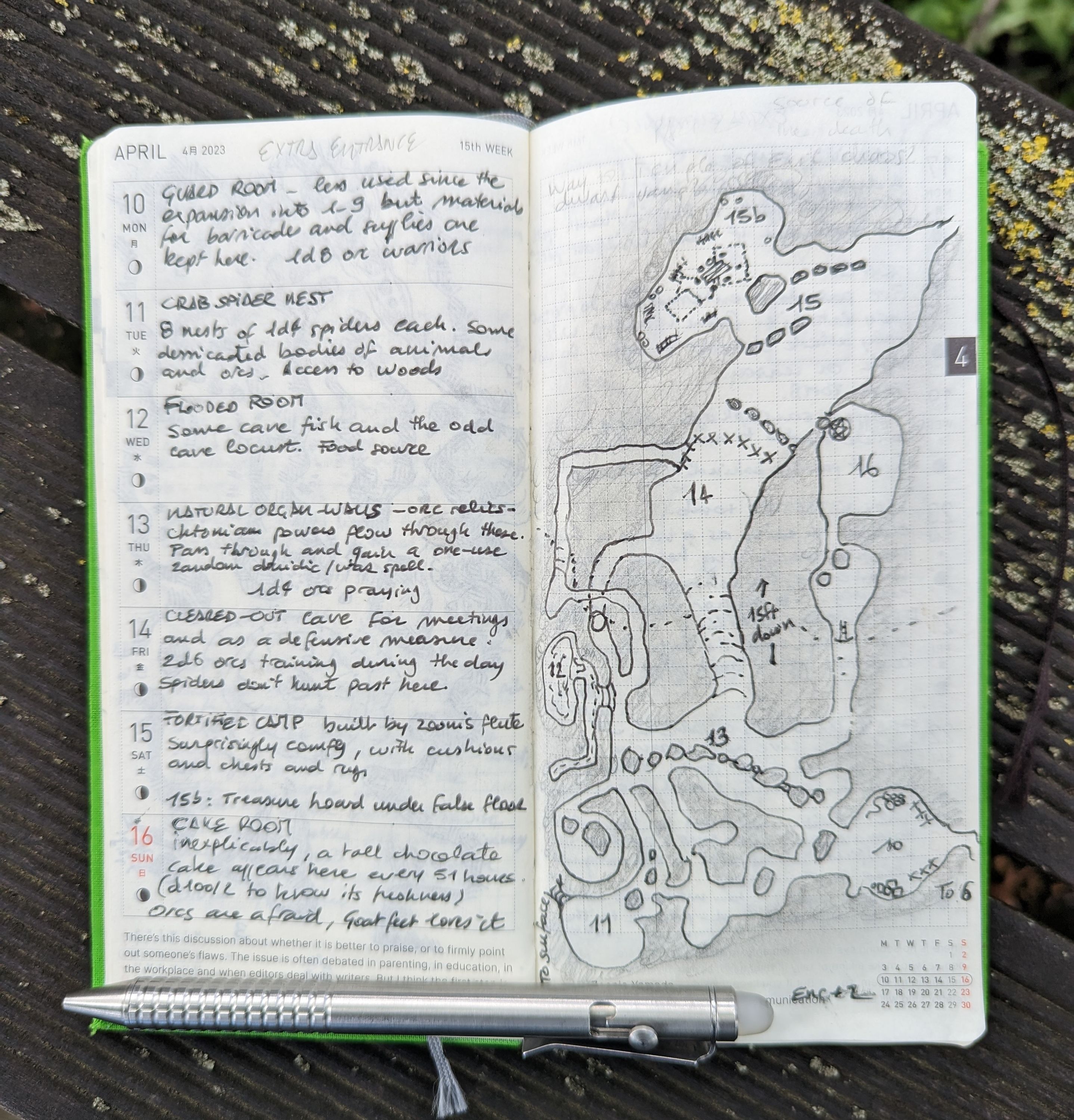 Adventurers caves
Adventurers caves
Room 16 has magical cake because it’s my birthday. Hey, one finds inspiration where one can.
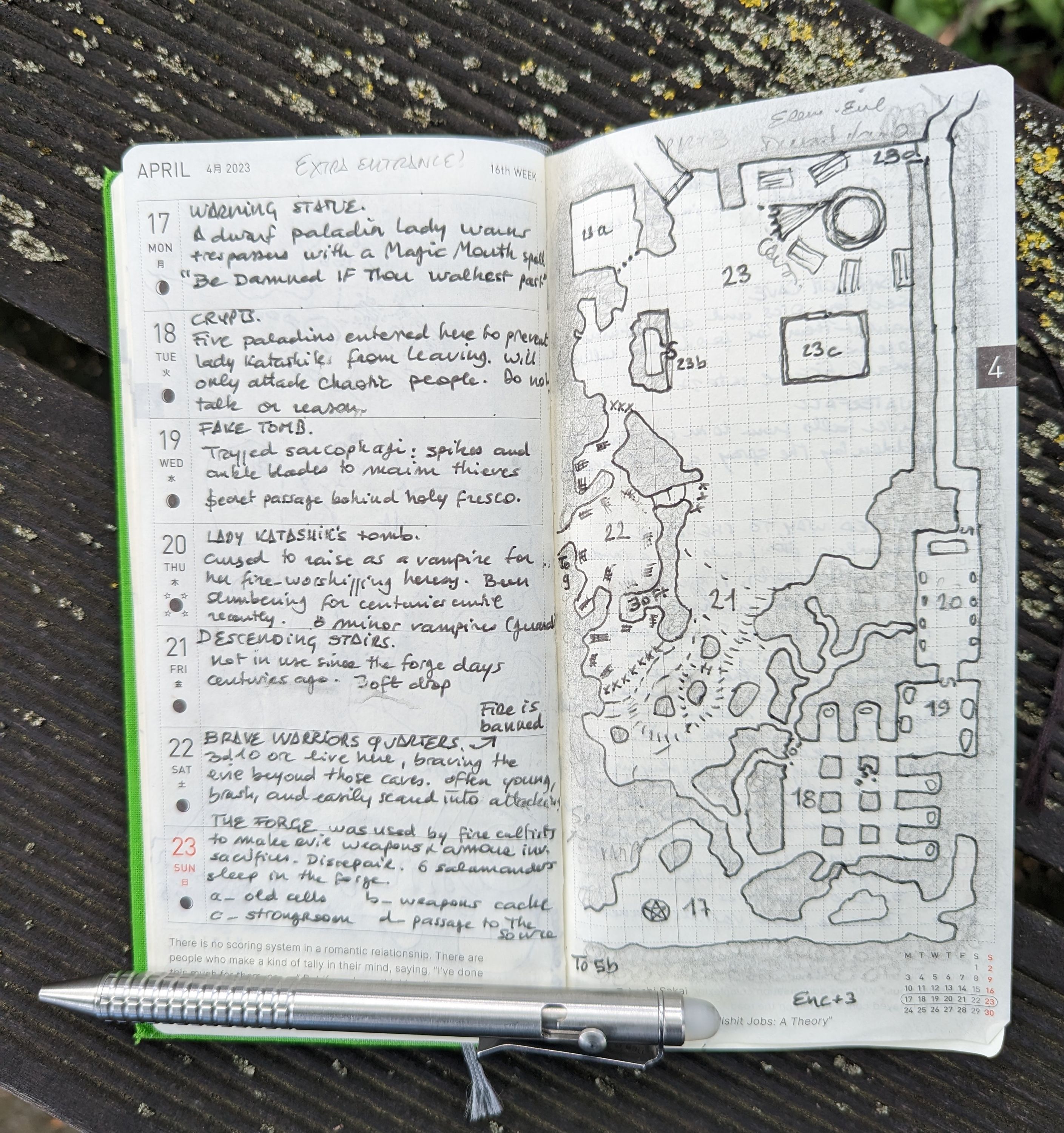 Abandoned dwarven forge
Abandoned dwarven forge
When looking for ideas I’d also rolled dwarves and vampires on the random tables. So I added a dwarf vampire! This rounded out the dungeon’s backstory: part of it was a religious forge whose master smith had turned away from the dwarven pantheon the worship fire (possibly because of the portal nearby). She was eventually destroyed for that heresy and laid to rest in a crypt but her patron gave her eternal life as a fire-vampire. Now she’s slumbering with her servants while the salamanders who came through the portal are resting inside the forge.
Of course, the new occupants (and the player characters) will soon wake up everyone…
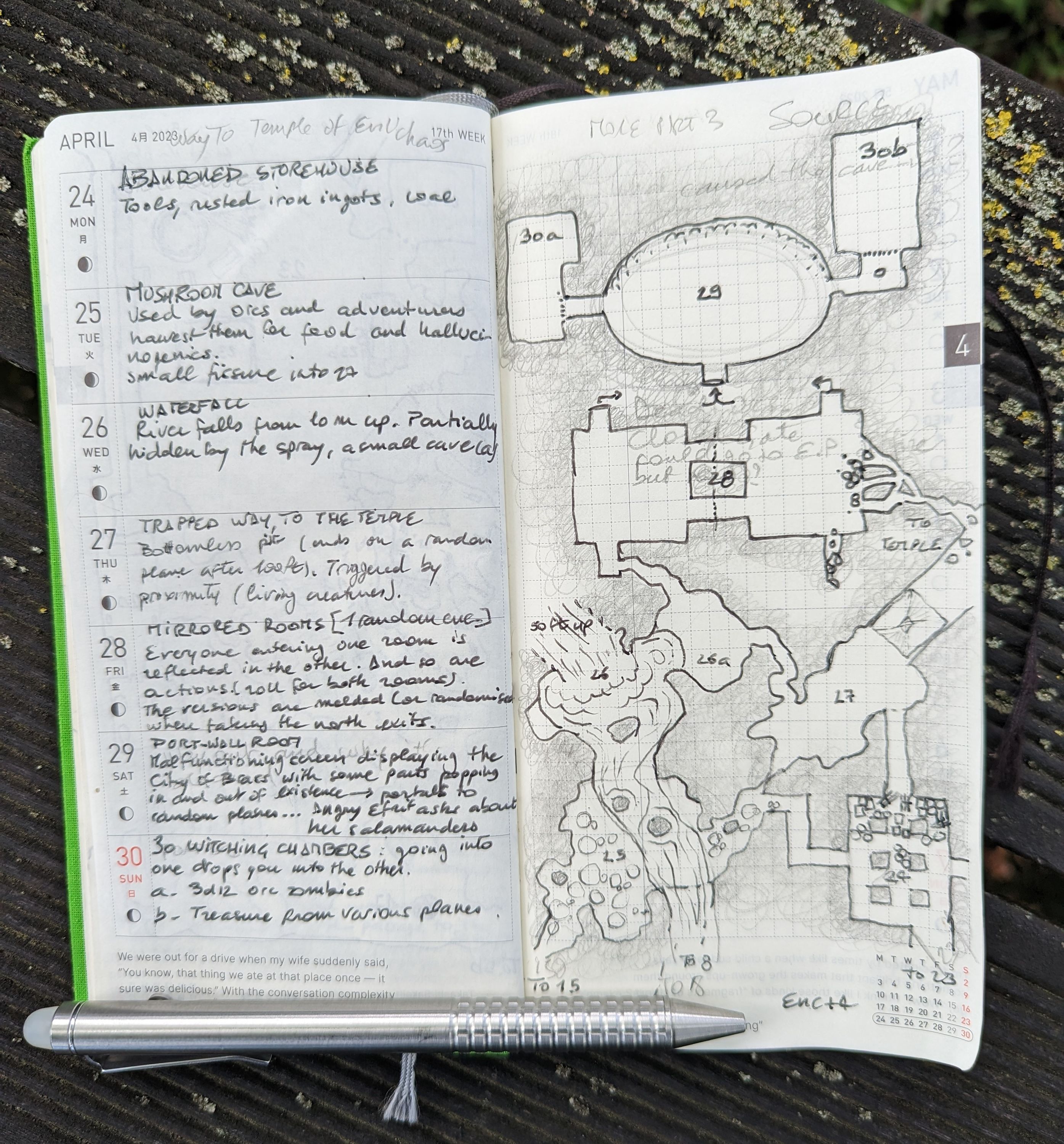 Portal and mushrooms
Portal and mushrooms
The final level has the start of the underground river seen at the entrance — which could be a shortcut between the two — the way into the Temple of Evil Chaos from B2, and the obligatory portal with some weird magic rooms.
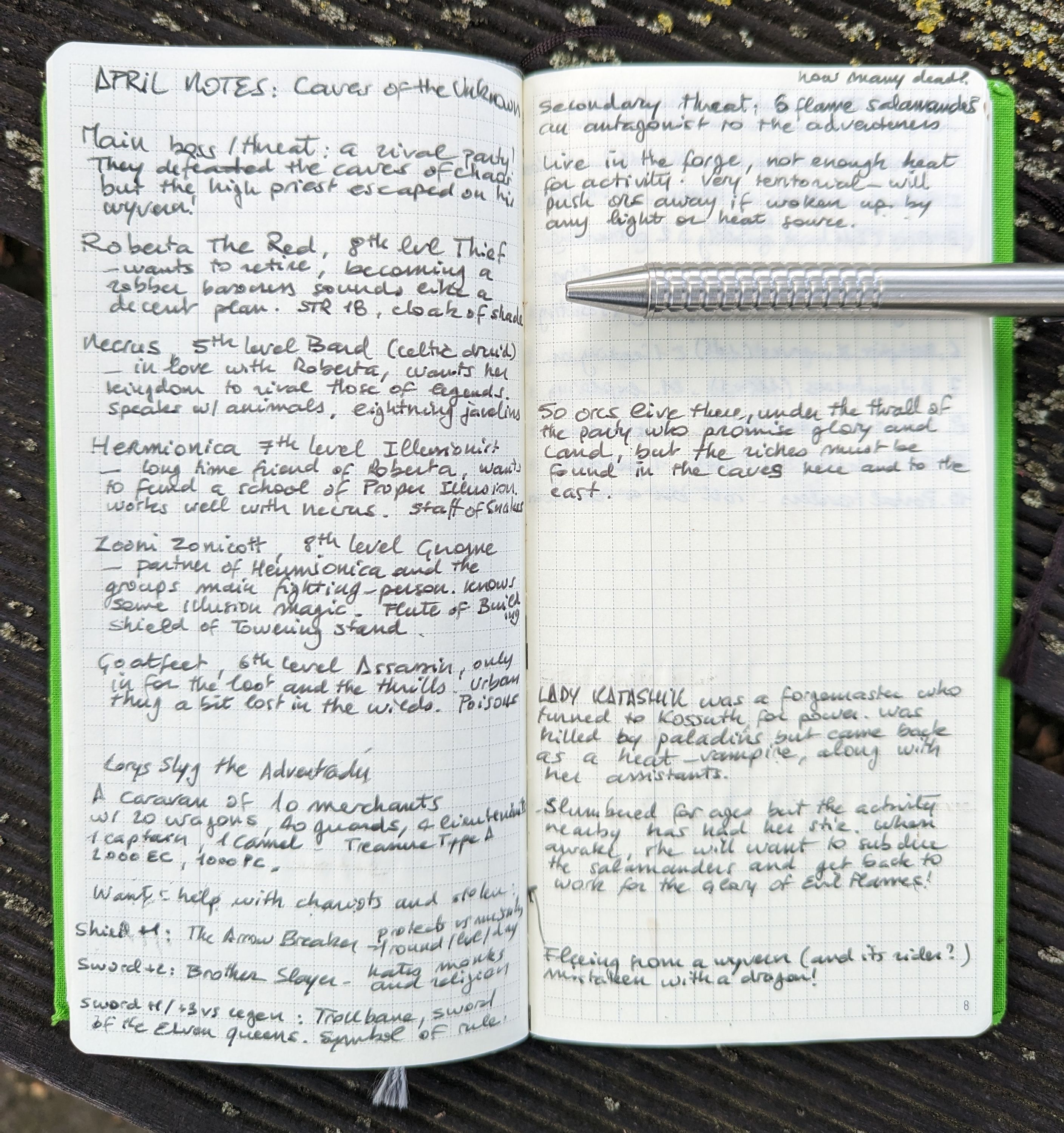 Notes
Notes
Finally, the notes I took at the beginning and later as I was adding rooms, and the random encounters I added today using a depth crawl style procedure.
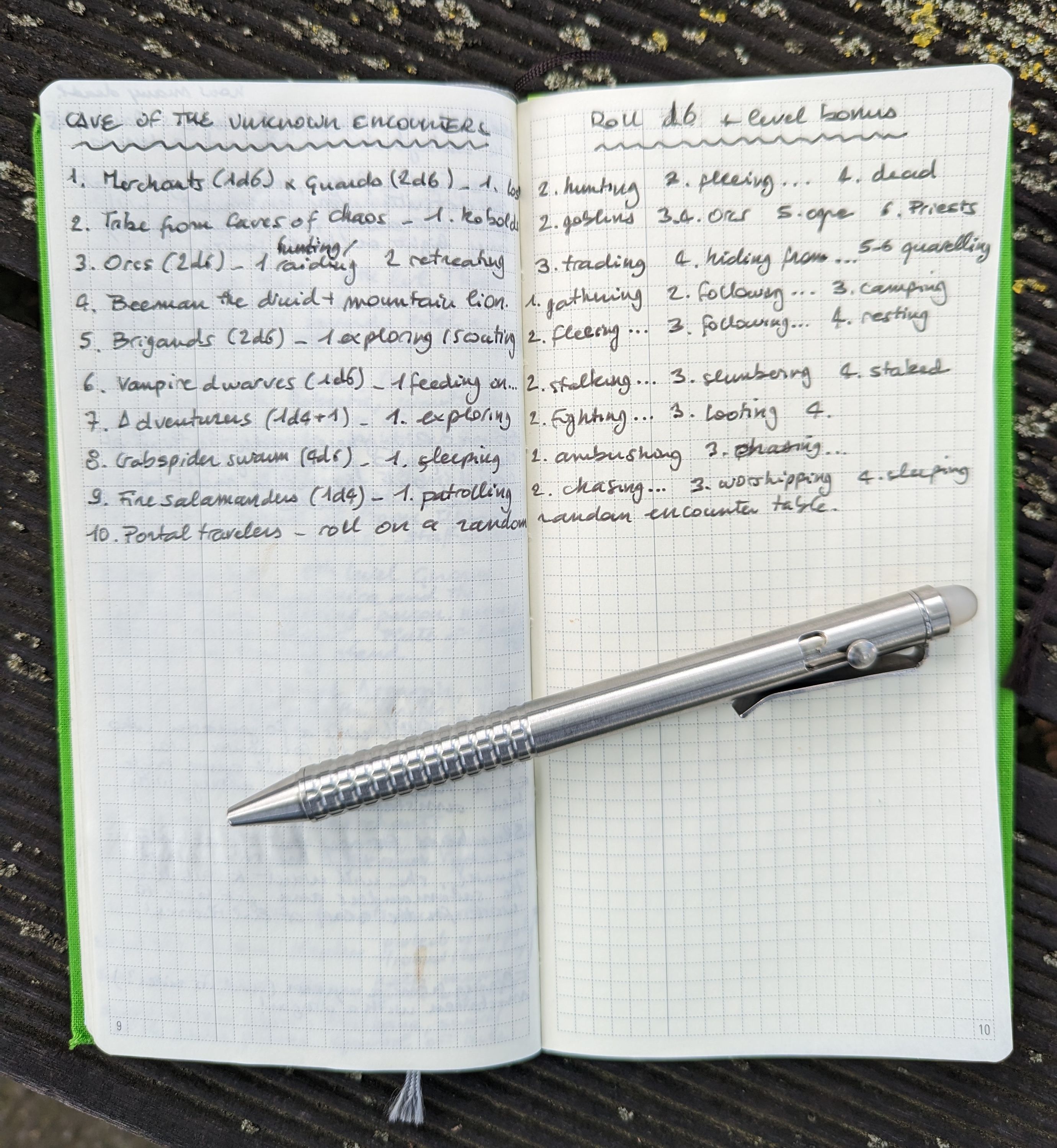 Random encounters
Random encounters
So I guess a City of Brass or other elemental plane of Fire dungeon would make sense for March. We’ll see what feels fun to do tomorrow. I have been thinking about post-apocalyptic stuff recently, so that might happen instead…
Hit Dice Should be Rolled, Take Two
I had a silly idea the other day. It should be an edit of my old hit dice post but since it’s been updated and published in KNOCK! #1, I don’t really see the point. (Or maybe I should republish the whole thing here? Sound off if you think it’s a good idea.)
Hit Dice Mean You’ve Been Hit
Simple, right?
When your character is hit by a monster, you roll a hit die: it’s a small, red d6 your referee gives you from the little bowl of small red d6s she keeps by her screen.
“A 5-in-6 chance of staying up when I’m hit? Easy!” You say. But no, because the next time you get hit, you roll your new hit die AND any hit dice you received previously. Your 16% chance to go down jumps to 30% with the second hit, and rises slowly after that. It’s at 84% with the 10th hit die.
It would make sense to have a limit to the number of hit dice a character can take, regardless of the roll. Say, twice their level for most classes, with once per level for magic-users and three times for fighters/barbarians?
Healing and resting is simple to handle: give the hit dice back to the referee, at a rate and under conditions aligned with your gameplay philosophy.
Critical hits and heavy weapons can simply confer more than one hit die to their target.
Taking Armour into Account
In a roll vs Armour Class system, it’s already taken care of. In a roll-under system, where armour reduces damage, an option is to have armour step the hit die up to d8. Heavy armour can step the die more than once, up to d12.
Which leads us to considering different hit dice types…
Class Hit Dice
Giving each class a different hit die makes immediate sense. Like, the same die your ruleset gives the class for its hit points.
A 5E barbarian will almost never go down until they’ve reached their hit dice limit. But they’ll never be certain they can tank the next blow.
A B/X magic-user, on the other hand, has 25% chance of going down from the first hit, and 43% on the second. But a lucky player may keep fighting for a good while!
Variable Damage
If classes don’t get a different die type, maybe weapons do? It becomes a bit counter intuitive as bigger weapons use smaller dice, but it probably works. You can also step a hit die down with a critical hit.
In Conclusion
I don’t know if I’d use this to replace hit points in a D&D game, but I’ll definitely consider it next time I’m working on an risk-and-reward, gritty ruleset. Or if I’m running an FKR session.
It would make damage rolls more tense and dramatic, and it feels like the accumulation of little red dice on your character sheet would build tension and push gamblers to risk their characters in wild ways.
Let me know if you try anything like this in one of your games!
CY_borg and Cinematic Gameplay in OSR games
Disclaimer: I’ve never played Mörk Borg. I barely even skimmed the book. The following might induce a big d’uh from you if you know the game well.
 The CY - screenshot from the book, art by Johan Nohr
The CY - screenshot from the book, art by Johan Nohr
On of my CY_borg players reflected the other night: “I like this gameplay, you can do cinematic shit but you’re still risking getting one-shotted.” Florian’s character had been using his flashy new opticamo’d quadcopter suit to jump onto a spider drone racing off the side of a megabridge. He managed to force open the access hatch and let the other players hack the drone from a stolen taxi racing through traffic on said megabridge. Fortunately, the highway SecOps were busy searching the rival party’s car when it all happened. (You can play drone hijacking hijinks too!)
As a GM with years of Feng Shui and PbtA games under my brainbelt, I may have had some input in how the session unfolded. I believe however that the main culprit for how epically this scene unfolded is the Stockholm Kartel and their rules engine.
I for one wouldn’t have expected a third wave OSR / NSR game to handle cinematic action like it did this weekend.
D’uh again, probably. Looking at these rules, it’s all in there and I’d probably seen it if I hadn’t been so lovestruck with the book’s setting and general jaw droppingness. Which made me think that old-school doesn’t have to rhyme with blood by the bucketful. You could make most adventure games feel more heroic while keeping them lethal to hotheads and unlucky dice rolles. It might not be what you want for your exploration of the Grimdark Dungeons of Grittiness by a rat-catcher and a one-armed goblin, but if you’d like to make you third level Old-School Essentials party a bit more Record of Lodoss War (let’s call it LodOSE because we’re smrat), there are a few aspects of CY_borg you could consider borrowing:
- Low difficulty rolls
- Ubiquitous equipment
- Powerful yet narrow magic
- Built in immediacy
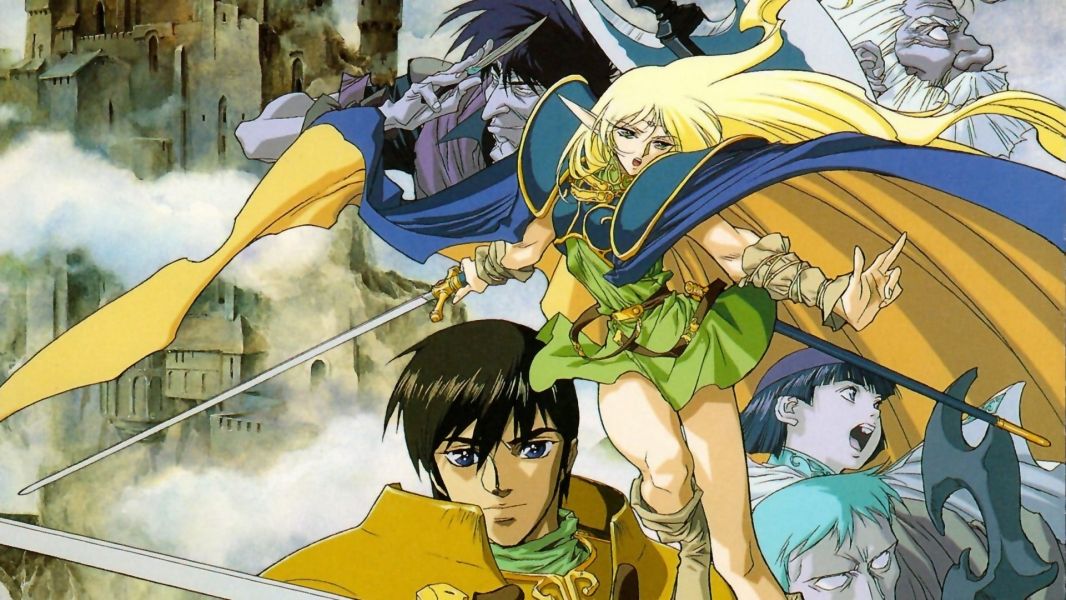 From Record of Lodoss War by Ryo Mizuno and Yutaka Izubuchi
From Record of Lodoss War by Ryo Mizuno and Yutaka Izubuchi
Relatively easy rolls
Abilities in CY_borg range from -3 to +3 at character creations (and up to +6 with experience and luck). You add one of these to a d20 roll, aiming for a difficulty of 6 (simple) to 18 (almost impossible). In combat, the difficulty to shoot, slash, dodge, or parry is almost always 12 (the GM doesn’t roll). Without running the stats in Anydice, it is kind of obvious player characters are more adept/luckier than your average sarariperson.
This isn’t hard to implement into your LodOSE War game: fiddle with armour class, chances-in-6, and thief skills to give the players an edge. Maybe give them hero points or miracles or something to let players reroll and cancel fumbles or killing blows - CY_borg has glitches for that.
Ubiquitous equipment
In a typical, urban Cyberpunk environment, ressource management shouldn’t be an issue (until of course it’s about hard cash and hit points), and packing the right gadget shouldn’t be a worry. I don’t mind retconning the purchase of an item that could have been handy when prepping the heist. (I might even allow glitches for flashback scenes along the lines of “I’d planned for exactly this.”)
In LodOSE, this is difficult to handle outside of a heist or investigative adventure. Unless you don’t really care about backpacks and strict equipment lists, in which case I’d recommend having either a Gear ressource that gets depleted when naming the item you need/have (I think Five Torches Deep does this, among others), or an Adventurer’s Pack item with the same effect, à la Dungeon World.
I’ll argue that hi-tech equipment is akin to magic in fantasy settings (often enough in OSR games, hyper advanced technology is the explanation for magic). Letting players come up with fun and useful cantrips or running a freeform magic system would also be very helpful.
Powerful yet narrow ‘magic’
CY_borg has several types of ‘magic’: hacker apps, nanomancer powers, and cyberware. Some characters start with one or more, and they can of course be acquired later if you work for it. To me, this is very much like the Vancian spells and magical items in a LodOSE campaign.
If you use rules that let anyone cast spells (or use spell-like items) like Into the Odd and its descendants, you’re golden. Otherwise, just be more generous with spell scrolls and have a few lists of minor magical items to sprinkle your treasure hoards with. And just watch your players do cool one-off, spotlight stealing, life saving actions.
Built in immediacy
This one’s a bonus, because it is world and adventure dependent. The CY, where CY_borg takes place, is an ageless, nigh-infinitely sprawling megacity. The game doesn’t expect you to ever leave the CY. And even if you did, chances are that everywhere else would be exactly the same.
More than any other genre I can think of, cyberpunk settings have in-built immediacy. Whether you need some dirt to blackmail a mobster, the bypass routine to get into their office, or the drug to give you that extra edge when you confront them, it’s a cryptransaction and a drone delivery away.
To get there in LodOSE, the setting’s magic would need to be tweaked (unless I’m misremembering the anime, it’s been a few decades). How much would it look like a boring runepunk setting from the 90s, I don’t know. Maybe leave the bonus out. Or don’t, and let me know how it works out for you.
#dungeon23 February, week 3
I’ve made good progress on the adventure location I’m writing for #CY_borg. I still don’t know where the planar portal is exactly, but there is a whole underground level to write still.
 February map part three
February map part three
Initiative as a Token
A long time ago, in a country far away I wrote a silly game about space Vikings. It has a mechanic that let you give the initiative away to the opposition in exchange for bonus dice. It’s not a bad idea, and I wonder why I’ve never thought of using something along those lines since then.
I like the idea of initiative as something you can take away from opponents, depending on how the flow of the fight goes. Fights can’t always be as elegant as the duel in Princess Bride but I think we can do better than just rolling a die.
All I have is a kernel of an idea that I’ll test in my next games (CY_borg or CRACK! not sure which will happen first). But here it is, directly from my brainmeat:
- Initiative is a physical token on the table. Use something cool looking.
- The side who initiates the attack starts with the initiative. Or roll if not sure.
- On their initiative, the players or the monsters/NPC act in the order they chose.
- Initiative can be lost:
- On a very bad roll or fumble
- As a payment to improve the result of a roll
- In exchange for better odds at a roll
- Initiative can be seized:
- With a very good or critical roll
- By succeeding at a specific action
- By not acting on your turn
You’d have to be very narrative focused to make this work. I don’t think it’d work in a grid-based, action economy environment like Pathfinder of the Ampersand Brand. But if you’re playing loosey-goosey, heroic games, you can easily make the iniative a stake of your fight scenes.
I’ll think of some examples when my brain isn’t as foggy as it is today (why else do you think I’m blogging on a Friday afternoon?)